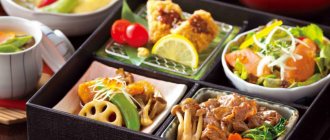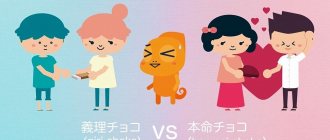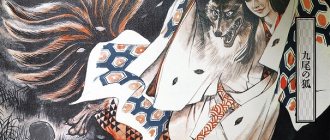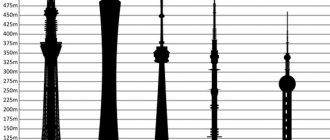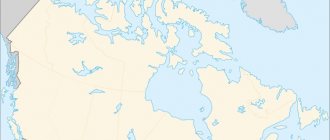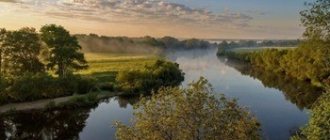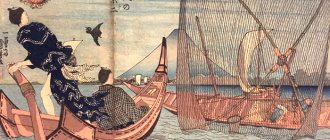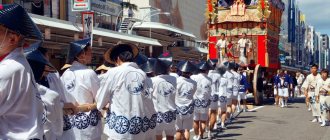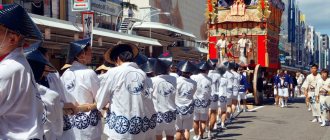The views of scientists and gerontologists have long been focused on the Japanese island, where the Earth's centenarians live. Scientists have unraveled the secrets of centenarians on the island of Okinawa, where the largest number of centenarians are over 100 years old.
We are accustomed to seeing old people helpless and frail, who need care, who are shackled by illnesses and diseases.
Okinawa's long-livers are full of strength and energy, many of them engage in feasible physical work and take care of themselves independently.
Long-lived people in Japan, do they have a secret?
Scientists note that per hundred thousand people in this place there are 50 centenarian men and women, while, for example, in America there are only 7-10 people for the same number of people. Japanese centenarians do not experience heart disease, cancer or diabetes until they are 80-90 years old, and they do not experience age-related Alzheimer's disease until they are 100 years old.
About 500 people live on the island, whose age has exceeded the century mark. The average life expectancy for men on the island is 78 years, and for women the average life expectancy is 86 years.
People are busy working and lead an active lifestyle, so they are physically strong and resilient, despite their advanced age. Thus, martial arts master Seikichi Uehara, at 96 years old, defeated a 30-year-old boxing champion, and Nabi Kinjo, at 105 years old, with quick reaction and strength, was able to swat a poisonous snake with a fly swatter. At the age of 90, many island residents, especially peasants, continue to work in the fields for 10-11 hours a day.
But it is also interesting that if a resident of the island changes his place of residence and accepts the lifestyle of the country to which he moved, then he becomes an ordinary person, with all the ailments and age-related changes inherent in him.
Therefore, scientists are increasingly inclined to the conclusion that longevity depends not only on the genotype, but also on a person’s lifestyle. What kind of lifestyle do the long-livers of the island of Okinawa lead in order to prolong their lives, being healthy and strong?
A lifestyle that leads to active longevity
The day before, I arrived in the village of Gozei in northern Okinawa, accompanied by two longevity specialists. We spent the day asking Godzei about her diet, learning about her lifestyle, and watching her prepare traditional Okinawan dishes.
We learned that this woman's life consists of a blessed routine. She lives alone in a house of three unfurnished rooms separated by rice paper doors. After waking up, she wraps her petite body weighing less than forty kilograms in a blue kimono and usually makes offerings to the ancestors in her living room, lighting incense at a small altar on which old photographs, a tortoiseshell comb, an urn and other relics left by her ancestors are placed.
During the cooler parts of the day, Godzei works in the garden, reads comics or watches baseball on TV in the afternoon, and then takes a short nap.
Every day after lunch, Godzei's neighbors visit him, and a couple of times a week (to drink tea with wormwood and talk) the moai come - four women who, in their youth, together with Godzei, promised to support each other throughout their lives. Whenever Godzei's life fell on hard times (a period of lack of money or the death of her husband 46 years ago), she could rely on their help and on yimaru - social obligations in the Okinawan sense.
Secrets of Okinawa's centenarians
The island of Okinawa is located in the tropical zone, where plants are exposed to the scorching rays of the sun more than usual. In the process of evolution, plants have learned to protect themselves from the harmful effects of sunlight; they produce photochemical elements and large amounts of antioxidants.
Predominance of plant foods
And plant antioxidants act as protectors of human health and youth, from the influence and harmful effects of free radicals, which cause early aging of the body.
- About the importance of plant products in the fight against aging, read: products that preserve youth. For Okinawans, it is considered normal to eat up to 10 servings of fruits and vegetables per day.
Low animal protein intake
In the scientific world, there is an assumption that animal proteins have a harmful effect on human health. They contain saturated fats and cholesterol, which cause the development of heart and vascular diseases, and the presence of sulfur amino acids in protein can change bone structure with age.
Okinawans, on the other hand, adhere to a plant-based diet. Their food consists of 80% greens, vegetables and fruits and 20% sea life and fish. They consume pork very rarely, during ceremonies and holidays, and probably organic meat. But often rice and fish.
On the table of centenarians there is always a dish of pig ears, which is considered a signature dish and does not contain fat, but contains a lot of calcium. Vegetables include pumpkin, sweet potatoes, tofu, and invigorate yourself with rice wine or vodka.
The presence of healthy fats and flavonoids in food
Many plants contain flavonoids, specific substances that protect human health. They have anti-inflammatory and antitumor effects, antioxidant and anti-radiation, wound healing and bactericidal.
All these properties are fulfilled by the food that the Japanese eat: flax seeds, miso soup is a thick soup made from beans, rice or barley that have undergone a fermentation process. Or tempeh, which is made from soybeans, is also a fermented product. Most of the diet consists of fish and seafood rich in Omega-3.
Restricting calories by under-satiation
Islanders never overeat. It is important, as long-livers note, to leave the table when you are only 80% full. Such minor calorie restrictions, according to scientists, provide many benefits for health and longevity.
Incomplete saturation of the stomach activates the processes of autophagy, when old cells are destroyed by healthy ones, thereby keeping the body in good shape and the person does not gain weight, but, on the contrary, loses weight if he is full.
There is another opinion of scientists on this matter, who claim that incomplete saturation of the stomach with food is a small stress that activates the body’s immune system. Ultimately, this has a positive effect on longevity genes.
Daily exercise
The people of Okinawa are very athletic and exercise their body and mind every day. They practice karate, yoga, tai chi, dancing, and martial arts, which are done outdoors in the sun, which allows them to replenish their body with vitamin D.
And vitamin D, as you know, not only strengthens bone tissue, mental activity, the occurrence of depression, and pressure surges depend on its presence in the body. Among the centenarians it is impossible to meet a smoker.
Positive attitude towards life
Residents living on the island are good-natured, friendly, and always smiling. They, as members of the same family, had common views on life. They know how to cope with stressful situations and never get depressed. They value family ties and family traditions. They never get angry, and perceive work as a joyful event.
Finding the meaning of life
The search for the meaning of life, or “ikigai,” is something that all island residents do when they retire. According to the tradition that has developed on the island, everyone should be busy with something when they retire. No one should live only for themselves and it doesn’t matter whether you are 60 or 90, you should benefit other people. Therefore, the Japanese are in search of a new mission for themselves and try to help each other.
Sociability and high spirituality
Despite the fact that in old age, long-livers live in families, they do not retire from people. They maintain close contact with centers created for older people, where they participate in clubs and interest groups, be it sports sections or folklore clubs.
They communicate with each other, take part in games and theatrical performances. Elderly people on the island are treated with honor and respect.
While studying in hobby clubs, they organize joint morning rituals or group meditations; women on the island are considered shamans and priestesses. They are interested in dancing and music. Okinawans believe that these activities help awaken the soul in a person.
Okinawa: the land of the lucky long-livers | Bigasia.ru
Okinawa Island is part of the Ryukyu Archipelago, located in the East China Sea. This piece of land is of coral origin, and due to the warm Kuroshio Current, the climate in Okinawa is humid and warm, with a lot of rain. Summer is long and hot, and winter, on the contrary, is very short and without snow. Bright hibiscus blooms almost all year round in Okinawa. The largest coral reef in Japan stretches along the island for a couple of tens of kilometers. The underwater world off the coast of Okinawa is quite diverse - there are even sea cows (dugongs), which are listed in the Red Book. The sea around Okinawa is rich in a variety of marine life, including the rarest species. Local residents also mine black pearls near the island, which are so valuable in jewelry. Not far from the island, some mysterious structures were discovered that were clearly of man-made origin - a stone arch and several pyramids. Some archaeological enthusiasts immediately declared that an ancient continent had been discovered off the coast of Okinawa - the legendary and mysterious Lemuria. In general, not an island, but an earthly paradise. However, in any barrel of honey there is always a fly in the ointment; the idyllic picture of life in Okinawa is spoiled by unwanted guests - powerful destructive typhoons that often visit the island. And from an economic point of view, Okinawa Prefecture is the poorest in Japan. Although this does not seem to bother Okinawans too much - they constantly organize colorful festive events - carnivals.
Traditional annual Okinawan dragon boat race. Photo: Issei Kato/Reuters
Naha, the main city of the island and the capital of the prefecture of the same name, is home to about 43 thousand inhabitants. In the Middle Ages, this city was the capital of the small Ryukyu kingdom, which was both politically and economically very closely connected with China, which could not but affect the culture and way of life of Okinawa. In the XII-XVI centuries. the kingdom flourished under the patronage of China and conducted brisk trade with Korea, Japan, and Southeast Asia. Then, at the beginning of the 17th century. it became part of Japan as a dominion, but the Ryukyu dynasty continued to maintain close contacts with the Middle Kingdom. It was only in 1879 that the Ryukyu Kingdom was annexed to Japan and renamed Okinawa Prefecture. The royal family was expelled from its residence, the magnificent Shurijo Palace, which today is one of the main tourist attractions on the island of Okinawa. This most beautiful creation of human hands has suffered a lot from time and enemy invasions, but now the palace has been restored and serves as one of the main concert venues of the island.
Okinawans have always considered themselves different from other Japanese. They themselves call this part of Japan Uchina, and call themselves uchinanthu, while all the other inhabitants of the Land of the Rising Sun for them are yamatonchu - the inhabitants of Yamato, that is, the rest of Japan. This is not surprising, since the significant distance from “greater Japan” and the peculiarities of historical development determined the uniqueness of this region of the country. Not long ago, Okinawans and other Japanese spoke literally different languages. Moreover, on the different islands of Okinawa Prefecture there were a great variety of different dialects, so that communication between residents, even within the prefecture, was complicated by mutual misunderstanding. However, this is now a thing of the past, and today the population of Okinawa speaks a common variety of Japanese. Only in the most remote and remote villages of the islands of the former Ryukyu Kingdom do some old people still communicate with each other in outdated dialects.
Okinawa Island from a bird's eye view. Photo: orientaltravel.ru
Okinawa is considered the birthplace of the martial art of karate. On the one hand, close relations with China allowed Okinawans to become acquainted with the martial arts of the Middle Kingdom. On the other hand, Okinawa has long developed its own original school of martial arts called Okinawa Te. After the capture of the Ryukyu Kingdom by Japanese samurai, martial arts practice in Okinawa was strictly prohibited. The death penalty was imposed for studying and practicing Okinawa Te. However, as often happens, martial arts in Okinawa went deep underground and developed “not because of, but in spite of.” Okinawan te masters spent decades perfecting their art, the main principle of which sounded rather gloomy: “kill with one blow.” Actually, this school became the progenitor of karate, which is so popular throughout the world today.
Okinawa is the “forge” of Japanese centenarians.
Photo: Yuya Shino/Reuters Okinawa has another interesting feature. This Japanese (or not quite Japanese?) island has the most centenarians. Maybe it’s thanks to the fertile climate and calm pace of life, or maybe it’s the balanced, healthy cuisine with an abundance of seafood that plays a positive role, but Okinawa is the world record holder for this indicator. The average age of men here is 78, and women - 86 years. They say that the islanders live so long because they have a meaning to life, which they call ikigai. By the way, this feature was known back in ancient China. No wonder the Chinese called the Ryukyu Islands the Land of Happy Immortals. It was rumored that the inhabitants of Okinawa were not made of flesh and blood, like all ordinary mortals, but of pure gold and silver. One Chinese emperor, in search of living grass that supposedly grew only in Okinawa and gave people immortality, even sent an expedition there. Alas, no one has ever found the magic herb in Okinawa. But Okinawans continue to live long and enjoy a happy old age, which, in their opinion, begins at 60 years old. And to solemnly celebrate the 97th anniversary - as a special milestone, marking the transition to a new life...
Japanese Diet: Okinawa
Okinawa is a kind of Japanese Hawaii, a group of exotic islands with a warm climate, palm trees and snow-white beaches.
For a thousand years, this Pacific archipelago has maintained a reputation as a region with a very high concentration of centenarians. Okinawans who are 65 years of age or older have the highest life expectancy in the world, with an average of 80 years for men and 88 years for women. It is believed that men in Okinawa have a good chance of living to 84 years of age, and women - up to 90 years of age. Among the inhabitants of Okinawa, there are the most centenarians in the world: approximately 6.5 out of 10 thousand people reach the age of 100 years or more.
They are also less likely to suffer from the diseases that kill Americans: Okinawa suffers five times less from heart disease, breast and prostate cancer, and cases of dementia are half as common as among Americans of the same age.
All Okinawan centenarians were born between 1903 and 1914, and for the first third of their lives, until about 1940, most of their calories (about 60 percent) came from one food item: the Okinawan sweet potato imo.
Purple or yellow sweet potatoes, related to our orange sweet potatoes, came to Okinawa from America about 400 years ago and did well in the local soil. On the eve of World War II, this vegetable became a real salvation for the population of Okinawa - without it, they would have starved. Rich in flavonoids, vitamin C, fiber, carotenoids and slow-release carbohydrates, sweet potatoes are one of the healthiest foods on the planet.
The traditional Okinawan diet consists of 80 percent carbohydrates. Before 1940, Okinawans also ate fish at least three times a week, along with seven servings of vegetables and one to two servings of grains per day. They also ate two servings of flavonoid-rich soy, mostly in the form of tofu.
The Okinawa diet did not contain much fruit, and eggs were consumed only a few times a week. Dairy and meat products accounted for just three percent of daily calories.
A typical traditional meal of the period began with miso soup, a local recipe made with seaweed, tofu, sweet potatoes and green leafy vegetables. The main dish was champuru - fried vegetables (goya, daikon radish, Chinese okra, pumpkin, burdock root or green papaya), sometimes with a small amount of fish, meat or noodles, seasoned with herbs, spices and oil. Drinks included freshly brewed sanpin (jasmine) tea and perhaps some awamori, a local alcoholic drink made from brown rice.
Three foods in the Okinawan diet of that time (turmeric, sweet potato, and seaweed) provided an additional benefit that we now understand much better: they mimic calorie restriction, providing a digestive diet that promotes longevity.
Diet rich in vegetables, soy and seafood
The traditional cuisine of the archipelago is rich in vegetables, soy and seafood. In January, Eat Lancet Commission scientists noted that this was broadly consistent with their model of “planetary health.” Behind this is a diet that has a particularly positive effect on human health and also helps reduce the negative impact on the environment.
In Okinawans, dishes are often prepared with sweet potatoes, green leafy lettuce and root vegetables, bitter melon and small amounts of fish and seafood, lean meats, fruits and tea. For example, a typical meal might include miso soup, stir-fried vegetables with seaweed, and a cup of freshly brewed jasmine tea.
Mannequins were developed for 2.5 million rubles. for training medical personnel
Miners began making farms from gaming laptops: up to $70 thousand in profit per year
WHO recommends vaccination against COVID-19 for mild cases
What is the reason for the loss of the traditional way of life?
The fact is that after the surrender of Japan in 1945, the island of Okinawa was under US control until 1972. During this time, the American way of life - unhealthy diet, cars, shopping malls, etc., greatly affected the lives of Okinawans. Old residents of Okinawa tell how, hungry and exhausted by the war, the Americans gave them the first chocolate, cheese, stewed meat, flour, etc. Once the residents tried American food, they couldn't stop. “We just couldn’t get enough of it, it was so delicious,” recalls 86-year-old Michiko Miyagi.
